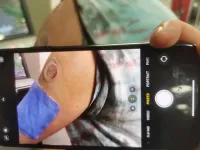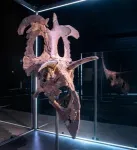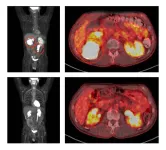(Press-News.org) PULLMAN, Wash. -- A wearable health monitor developed by Washington State University researchers can reliably measure levels of important biochemicals in sweat during physical exercise.
The 3D-printed monitor could someday provide a simple and non-invasive way to track health conditions and diagnose common diseases, such as diabetes, gout, kidney disease or heart disease.
Reporting in the journal, ACS Sensors, the researchers were able to accurately monitor the levels of volunteers’ glucose, lactate and uric acid as well as the rate of their sweating during exercise.
“Diabetes is a major problem worldwide,” said Chuchu Chen, a WSU Ph.D. student and first author on the paper. “I think 3D printing can make a difference to the healthcare fields, and I wanted to see if we can combine 3D printing with disease detection methods to create a device like this.”
For their proof-of-concept health monitor, the researchers used 3D printing to make the health monitors in a unique, one-step manufacturing process. The researchers used a single-atom catalyst and enzymatic reactions to enhance the signal and measure low levels of the biomarkers. Three biosensors on the monitor change color to indicate the specific biochemical levels.
Sweat contains many important metabolites that can indicate health conditions, but, unlike blood sampling, it’s non-invasive. Levels of uric acid in sweat can indicate the risk of developing gout, kidney disease or heart disease. Glucose levels are used to monitor diabetes, and lactate levels can indicate exercise intensity.
“Sweat rate is also an important parameter and physiological indicator for people’s health,” said Kaiyan Qiu, Berry Assistant Professor in WSU’s School of Mechanical and Materials Engineering.
But the amount of these chemicals in sweat is tiny and can be hard to measure, the researchers noted. While other sweat sensors have been developed, they are complex and need specialized equipment and expertise to fabricate. The sensors also have to be flexible and stretchable.
“It’s novel to use single-atom catalysts to enhance the sensitivity and accuracy of the health monitor,” said Annie Du, research professor in WSU’s School of Mechanical and Materials Engineering. Qiu and Du led the study.
The health monitor the researchers developed is made of very tiny channels to measure the sweat rate and biomarkers’ concentration. As they’re being fabricated via 3D printing, the micro-channels don’t require any supporting structure, which can cause contamination problems as they’re removed, said Qiu.
“We need to measure the tiny concentrations of biomarkers, so we don’t want these supporting materials to be present or to have to remove them,” he said. “That’s why we’re using a unique method to print the self-supporting microfluidic channels.”
When the researchers compared the monitors on volunteers’ arms to lab results, they found that their monitor was accurately and reliably measuring the concentration of the chemicals as well as the sweating rate.
While the researchers initially chose three biomarkers to measure, they can add more, and the biomarkers can be customized. The monitors were also comfortable for volunteers to wear.
The researchers are now working to further improve the device design and validation. They are also hoping to commercialize the technology. The WSU Office of Commercialization has also filed a provisional patent application to protect the intellectual property associated with this technology.
The work was funded by the National Science Foundation and the Centers for Disease Control and Prevention, as well as through startup funds.
END
Sweat health monitor measures levels of disease markers
2024-06-20
ELSE PRESS RELEASES FROM THIS DATE:
Scientists devise algorithm to engineer improved enzymes
2024-06-20
Scientists have prototyped a new method for “rationally engineering” enzymes to deliver improved performance. They have devised an algorithm, which takes into account an enzyme’s evolutionary history, to flag where mutations could be introduced with a high likelihood of delivering functional improvements.
Their work – published today in leading journal Nature Communications – could have significant, wide-ranging impacts across a suite of industries, from food production to human ...
We may soon be able to detect cancer with AI
2024-06-20
A new paper in Biology Methods & Protocols, published by Oxford University Press, indicates that it may soon be possible for doctors to use artificial intelligence (AI) to detect and diagnose cancer in patients, allowing for earlier treatment. Cancer remains one of the most challenging human diseases, with over 19 million cases and 10 million deaths annually. The evolutionary nature of cancer makes it difficult to treat late-stage tumours.
Genetic information is encoded in DNA by patterns of the four bases—denoted by A, T, G and C—that make ...
Rate of cannabis use disorder during pregnancy increased over 20% after cannabis legalization in Canada
2024-06-20
In October 2018, Canada enacted the Cannabis Act in Canada (CAC), which legalised the non-medical use of cannabis. A new study has found that the rate of cannabis-related disorders diagnosed among pregnant women in the Canadian province of Québec increased by more than 20% after the enactment of the CAC, while rates for all other drug- and alcohol-related disorders remained stable. The study is published today in the scientific journal Addiction.
This study measured changes to the monthly rates of diagnosed cannabis-related disorders (CRDs) in the pregnant population in Québec. Since 2010 the monthly average number of CRDs has increased consistently, ...
Among cancer survivors, LGBTQ+ individuals report higher prevalence of chronic health conditions, disabilities, other limitations
2024-06-20
Bottom Line: Cancer survivors who identify as lesbian, gay, bisexual, transgender, queer, or anything other than straight and cisgender (LGBTQ+) experience more chronic health conditions, disabilities, and other physical and cognitive limitations than non-LGBTQ+ cancer survivors; however, the prevalence of most conditions was highest among transgender or gender non-conforming (TGNC) individuals.
Journal in Which the Study was Published: Cancer Epidemiology, Biomarkers & Prevention, a journal of ...
Improving crops with laser beams and 3D printing
2024-06-20
A demonstration of how new technologies can be used in 21st century crop breeding comes from just published research that combines Laser Scanning and 3D printing to create a detailed 3D model of a sugar beet plant. Taking the next step beyond having genetic information to guide intelligent breeding, the 3D plant models here capture the essential characteristics of the above-ground parts of the sugar beet plant and can be used for AI-assisted crop improvement pipelines. The sugar beet plant models are reproducible and fit for field use. All the research information, data, methodology, as well as the 3D printing files are freely ...
Government’s failure to fortify all flour and rice with sufficient folic acid will lead to avoidable birth defects, warns expert
2024-06-20
The UK government’s failure to fortify all flour and rice with the vitamin folic acid “will result in more deaths and birth defects every year that could have been prevented,” argues Professor Sir Nicholas Wald in The BMJ today.
He warns that the current government’s proposal to fortify only one type of flour (non-wholemeal wheat flour) at an inadequate level will prevent only about 20% of neural tube defects, much less than the approximate 80% that could be prevented with fully effective fortification.
“What the government has done is a useful ...
Walking brings huge benefits for low back pain, study finds
2024-06-20
Adults with a history of low back pain went nearly twice as long without a recurrence of their back pain if they walked regularly, a world-first study has found.
About 800 million people worldwide have low back pain, and it is a leading cause of disability and reduced quality of life.
Repeated episodes of low back pain are also very common, with seven in 10 people who recover from an episode going on to have a recurrence within a year.
Current best practice for back pain management and prevention suggests the combination of ...
Study finds one copy of protective genetic variant helps stave off early-onset Alzheimer’s disease
2024-06-19
KEY TAKEAWAYS
An international team, including researchers from Mass General Brigham, has been searching for protective genetic variants in a family that includes more than 1,000 individuals who are genetically predisposed to develop early onset Alzheimer’s disease in their 40s.
Previously, the researchers identified the “Christchurch variant” as potentially protective against Alzheimer’s based on one family member who had two copies of this variant and was expected to develop dementia in her ...
Combination targeted treatment produces lasting remissions in people with resistant aggressive B-cell lymphoma
2024-06-19
Embargoed for Release
Wednesday, June 19, 2024
5:00 p.m. ET Contact: NCI Press Office
240-760-6600
NCIPressOfficers@nih.gov
NOTE: A virtual briefing is scheduled for Tuesday, June 18, 2024, at 1:00 p.m. ET. Details below.
Researchers at the National Institutes of Health (NIH) have developed a non-chemotherapy treatment regimen that is achieving full remissions for some people with aggressive B-cell lymphoma that has come back or is no longer responding to standard treatments. The five-drug combination targets multiple molecular pathways that diffuse large B-cell lymphoma (DLBCL) tumors use to survive.
In ...
Common prostate drugs tied to lower risk of dementia with lewy bodies
2024-06-19
EMBARGOED FOR RELEASE UNTIL 4 P.M. ET, WEDNESDAY, JUNE 19, 2024
MINNEAPOLIS – Certain drugs used to treat urinary symptoms due to an enlarged prostate may be associated with a reduced risk of dementia with Lewy bodies, according to a study published in the June 19, 2024, online issue of Neurology®, the medical journal of the American Academy of Neurology. Dementia with Lewy bodies is a progressive neurodegenerative disorder that can cause memory and thinking issues, movement problems and issues such as hallucinations.
The results do not prove that these drugs reduce the risk of dementia ...





